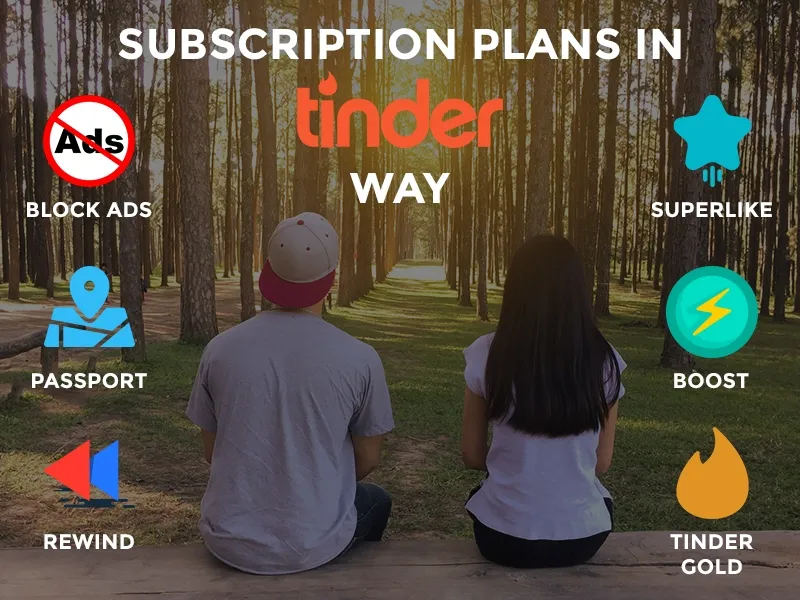Learning the Concept of Subscription Plans from Tinder
Tinder is definitely the topmost player in the dating game and so your tinder similar app plan.
And why not?
Talking of the existing day, it is worth a whopping 3 Billion USD after Uber and Airbnb!
Now to acclaim such a hefty amount that too being modest at its best surely needs an insightful business foresight and clever subscription plans.
Dating was a want. Tinder made it a need.
You should read more about how you can win against Tinder here.
With this need, aroused desperation and this desperation blissfully served Tinder to the unparalleled business position it is in.
The plan that it lay was simple – go with the MVP and charge for the advanced set of features aka Tinder Plus.
Now, not all the users would want to burn a hole in their pockets with the advanced subscription plans. But Tinder was clever enough!
Tinder Charges
It charged $9.99/month for the users under the age of 30 years and $19.99/month for users over the age of 30 years.
Here understand why such an age-bias by Tinder:
1. The Tinder users under the age of 30 are less serious into dating though being active. They can dexterously get multiple dating options in the real world as well and Tinder is mostly a helm to their dating game.
And so the younger generation is charged with a lesser subscription fee.
2. With age, the desperation to date increases amongst the people roving around with a cordon exhibiting the ‘Single’ status. Hence, they are the ones that can put the screws to the remunerative cast of Tinder.
Just go on pinching the age factor and draw in as much as you can!
Apart from this, there are certain features that leave the users hedging over and craving more access for it. And Tinder fills in the gap by providing the advanced set of features.
Basically, Tinder came up with two types of plans:
1. Tinder Plus

2. Tinder Gold

The Features of Tinder Plus:
· Rewind:

Targeted Instance:
The Tinder users are so much involved in the swiping that they get accustomed to it.
Now say for instance they go on passing the profiles by swiping left, and all of a sudden they see their potential match but since they are habituated to swiping left, they completely are into it and can follow the same pattern, thereby losing a good match.
The Cut Through:
The rewind feature is such that if the user has mistakenly swiped left to a profile, they can get them back and mend their ways. The same feature can also be used if in case the user has swiped right to a profile.
· Unlimited Right Swipes

Targeted Instance:
Tinder made it easy to show if you are interested in someone – that is just by swiping right. Now, the hedge of such a feature is, it provides the user with just 100 likes for 12 hours. Once the users exceed the limit, they are supposed to wait for another 12 smaller-hand ticks to swipe it right.
The Cut Through:
With such a limitation, the users are to become more picky about whom they swipe right and ultimately get lesser matches. This will cause an adverse effect on the overall interactivity of the platform.
Thus, the best way to provoke the users to break through the limitation and exhaust the ‘swipe left’ feature, Tinder provides the option to subscribe for unlimited right swipes.
· 5 Super Likes a day

Targeted Instance:
It is a lot easier to get lost in the crowd of appealing profiles and pictures, clicked at various angles. How do the users then make their way to somebody they have spent their precious ‘superlike’ on?
Umm…Precious superlike?
Yes! That’s because the users only get a superlike a day. Use it or run out. It’s just one.
Say for instance a user is too much serious about the profile he views and swipes right. What are the chances or let’s say probability that the profile of this desperate user appears into the feed of another user and they right swipe it?
Quite hard to say, right?
The Cut Through:
Using the Superlike feature, the users are likely to match with someone the users Super like as they get notified about the user who have spared their one big power just so that the user can acknowledge them.
Again, the Superlikes come with a limitation of being ‘1’ for the entire 24 hours and not everybody who is superlike are super likely to respond. Thus, increasing the number of superlikes and making a cut.
Using the superlike feature, the users are three times more likely to match with someone they superlike and the conversations initiated by it last for 70% longer.
· No Ads

Targeted Instance:
Ads, no matter in whatever form, create a noise when the users are running a marathon full of swipes. These ads can be in two types. The skip-able ones and the server-stitched or embedded ones. Not to mention the side pop-ups and pushed ones. The user has to wait for that time instant to perform his action.
The Cut Through:
Being a dedicated application, for the elimination of the ads, a designated subscription plan is introduced in the business model. The same is followed by Tinder – It charges the user a fee for providing them with an ad-free experience.
· Hide Distance

Targeted Instance:
Agree no matter what – when the users see the physical proximity being lesser, they are more likely to connect with them. But what about the time when the user travels abroad or to a place far off for let’s say a business tour or a vacation?
Simple! The distance shown consequently increases and it might turn off to many.
Also, when the user returns to from the trip, all he is displeased seeing no matches.
The Cut Through:
The hide distance option seems useful when the user is passporting to a faraway place. This in turn, hides the physical proximity so that the people don’t swipe left because they see a huge distance indicated in the user’s profile as pre-swipe in their next- vacation location.
· Hide Age

Targeted Instance:
While playing the dating game, age matters a lot. While nobody would want to date an elder, Tinder introduced the compulsion to add age in the bio.
Other way around, the data is directly imported from the Facebook profile of the user.
This way the user gets to see the age along with the profiles of their potential dates.
The Cut Through:
Age isn’t an attractive factor for everybody and not everybody sportingly takes the fact that ‘Age is but just a number’.
With age present in the bio of a user, there are high chances of him getting judged based on his age.
The hide-age feature provides the user with an option to hide their age and replace it with a blank space.
· Control Whom you See:

Targeted Instance:
The profiles that the users get to see are not just by mere coincidence. Tinder shows profile based on various factors, but most importantly the feed is based on the user’s score and how recently they were active.
Now, what about the user who doesn’t get online much but still is an active participant? He’d surely miss the feeds.
The Cut Through:
Basically, the users can control their profile views and what they see on the basis of two choices:
1. Balanced Recommendations
This is a standard setting for free users. It happens on the basis of their score and their potential date’s score and how recently active they are.
2. Recently Active
This feature sorts profiles on the basis of their ‘last online’ time. If the users are finding their right swipe quota noticeably dropping when they switched to ‘Recently Active’, they can relatively safely assume that their score is above average.
The benefit of seeing all active profiles within the users criteria is that there is a chance of matching these people.
· Passport:

Targeted Instance:
What about the users who have to often travel between cities or go in through different locations?
This is when they have to give up on their profile and visibility when they are passporting.
Now, imagine, this instance can be too frequent for a definite class of people and in that terms, it is pretty easy for the platform to lose its traction by missing out so many interaction instances.
The Cut Through:
The passport feature is useful if the user want to gather some matches in their next vacation destination before they get there.
Using this feature, Tinder will treat the user’s profile as if the user is already present at that location.
While there, the user will not be shown to people at home, except for the ones they have already swiped right on.
· Boost:

Targeted Instance:
As said earlier, it is pretty easy to get lost in the pool of profiles. No matter how much easy the user can think it is to outstand with their profile, but how to get through the reach.
The Cut Through:
Using the boost feature, Tinder places the user’s profile card near the top of the deck of people they have liked, whether they are currently online or not.
· Tinder Gold

Targeted Instance:
Going through the ample of profile and swiping right with the hopes to get matched may sometimes seem vain when no clear results are obtained.
The Cut Through:
This feature launched by Tinder helps to swipe through people’s profiles in the hopes of getting matches. After purchasing the a subscription, the user will be able to see their likes on the same screen where the users view matches daily.
Conclusion:
Planning a subscription is easy, tough part is to have it executed in a designated manner. Tinder has a well-thought subscription plan and is implemented by the users exactly the way it should have been. All appreciation to the intensive business strategy of Tinder.
Summarizing, it goes like, when planning for the subscription model, make sure you don’t stuff the features in the launch itself.
Let the users use your dating app, feel the missing element, get back to you, and then charge them as you wish.
Have additions to make tinder similar app plan?


